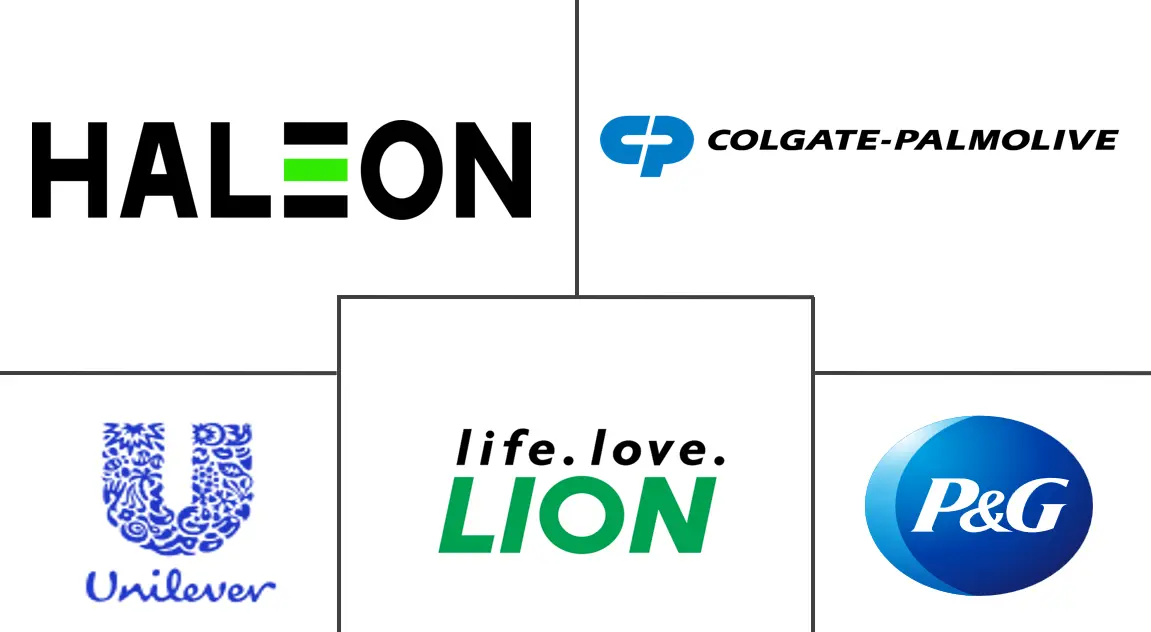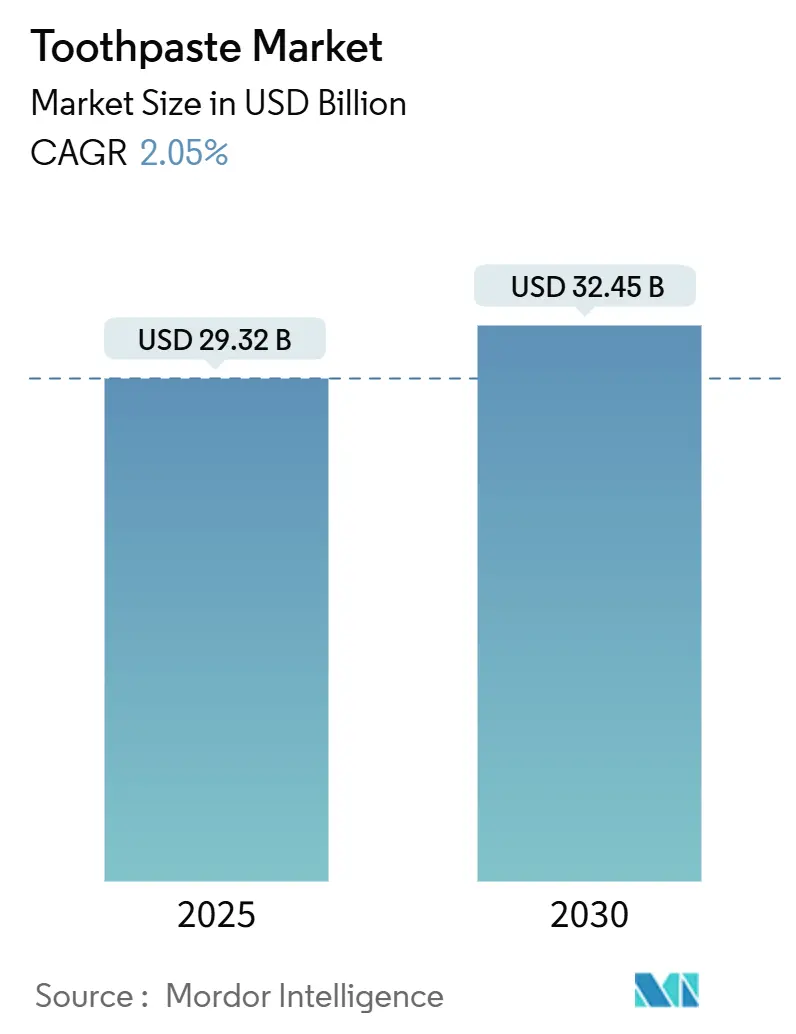
Toothpaste Market Analysis by Mordor Intelligence
The Toothpaste Market size is estimated at USD 29.32 billion in 2025, and is expected to reach USD 32.45 billion by 2030, at a CAGR of 2.05% during the forecast period (2025-2030). In mature economies, growth is steady, while emerging nations are experiencing significant expansion due to increasing awareness of oral hygiene. The toothpaste market benefits from its essential nature as a daily-use product, which insulates it from severe cyclicality. Regulatory bodies continue to endorse fluoride formulations, reinforcing consumer confidence and sustaining baseline demand. Additionally, brand owners are leveraging innovation by incorporating advanced features, such as enamel-strengthening amino acids, into standard toothpaste formulations to maintain their competitive edge. Simultaneously, the growing demand for natural and transparent ingredient-based products is fueling the rapid growth of natural toothpaste lines. Furthermore, sustainability regulations and evolving omnichannel purchasing behaviors are transforming cost structures. In response, market players are redesigning packaging solutions and intensifying their digital engagement strategies to adapt to these changes.
Key Report Takeaways
- By product type, standard variants led with a 55.45% revenue share in 2024, whereas functional and medicated formats are forecast to grow at a 2.55% CAGR to 2030.
- By category, conventional formulations captured 74.35% of the toothpaste market share in 2024; natural/organic lines are set to expand at a 2.95% CAGR.
- By end user, adults accounted for 84.35% of consumption in 2024, while the kids segment is on track for a 3.27% CAGR through 2030.
- By distribution channel, supermarkets/hypermarkets retained 31.43% share of the toothpaste market size in 2024; online retail is rising fastest at 3.75% CAGR within the toothpaste market.
- By geography, Asia-Pacific commanded a 34.57% share of the toothpaste market in 2024 and is projected to post a 4.25% CAGR to 2030.
Global Toothpaste Market Trends and Insights
Drivers Impact Analysis
| DRIVER | (~) % IMPACT ON CAGR FORECAST | GEOGRAPHIC RELEVANCE | IMPACT TIMELINE |
|---|---|---|---|
| Growing consumer shift toward herbal and natural formulation-based products | +0.8% | Asia-Pacific core; spill-over into North America and Europe | Medium term (2-4 years) |
| Sensitive tooth-based toothpaste gaining popularity | +0.4% | Global, accentuated in aging populations | Long term (≥ 4 years) |
| Aggressive marketing and advertising by brands | +0.3% | Worldwide, heavy emphasis on digital channels | Short term (≤ 2 years) |
| Product differentiation in terms of ingredients and functionality | +0.5% | Primarily developed markets; progressively emerging markets | Medium term (2-4 years) |
| Favorable government initiatives on oral hygiene | +0.2% | Asia-Pacific | Short term (≤ 2 years) |
| Deterring oral health surge market growth | +0.4% | Global | Medium term (2-4 years) |
| Source: Mordor Intelligence | |||
Growing consumer shift toward herbal and natural formulation-based products
As consumers grow wary of synthetic ingredients and with regulatory bodies backing traditional remedies, the demand for natural and herbal toothpaste is on the rise in the toothpaste market. This trend underscores a significant shift: health-conscious buyers now value ingredient transparency more than brand loyalty. In India, for instance, Dabur has noted a 31% market penetration for its natural products, alongside a 13% growth in its portfolio. The World Health Organization's endorsement of herbal remedies, particularly those featuring neem, clove, and turmeric, has bolstered their credibility in dental care. Furthermore, the advent of nanotechnology in herbal formulations promises to boost the bioavailability of these ingredients, bridging the performance gap with conventional products. This innovation is paving the way for hybrid products that meld traditional herbal elements with cutting-edge delivery systems, catering to the changing preferences of consumers. Yet, manufacturers face a challenge: navigating the intricate web of regulatory standards that differ widely across regions, especially when it comes to defining and standardizing natural products.
Sensitive tooth-based toothpaste gaining popularity
The aging population's susceptibility to dentin exposure and gum recession is driving demand for sensitivity-focused toothpaste, boosting growth within the toothpaste market. In 2023, 19% of U.S. adults reported toothache-related issues, highlighting a market opportunity for targeted oral care solutions [1]Source: CareQuest Institute for Oral Health, "State of Oral Health Equity in America 2023", www.carequest.org. Premium-priced products with clinically validated ingredients like potassium nitrate and strontium chloride appeal to healthcare professionals and informed consumers. Industry leaders are addressing specific oral health needs; for instance, in February 2025, Sensodyne launched its Clinical Repair range, including Deep Clean and Active White variants. Rising demand for whitening products, despite sensitivity challenges, is fostering innovation in dual-benefit formulations. Consumer education and dental professionals remain critical to driving product adoption.
Aggressive marketing and advertising by brands
In Southeast Asia, platforms like TikTok are driving product visibility in the toothpaste industry and revenue growth for emerging players like SPLAT. Brands are shifting from traditional media to influencer partnerships and social commerce, while established manufacturers increase marketing investments to protect market share from direct-to-consumer competitors. These competitors use targeted advertising and subscription models to bypass traditional retail channels. Performance marketing enables brands to link advertising spend to sales, but rising customer acquisition costs pressure margins for those lacking scale efficiencies. Colgate-Palmolive's focus on digital marketing and e-commerce highlights the industry's shift toward online consumer discovery and purchasing, especially among younger consumers prioritizing convenience and reviews over brand heritage. Brands with advanced data analytics and agile creative capabilities are best positioned to benefit, while traditional players must balance digital investments with retail partnerships.
Product differentiation in terms of ingredients and functionality
Businesses are moving beyond basic cleaning to offer specialized benefits like enamel strengthening and cosmetic enhancements in the toothpaste market. Companies are pouring resources into proprietary ingredient technologies to carve out competitive market positions. For example, in May 2023, Colgate unveiled its Strong Teeth formulations, leveraging Arginine technology. This move highlights a shift towards amino acid chemistry, addressing specific oral health needs, and stepping beyond the traditional fluoride solutions. Moreover, in markets like Vietnam, where regional texture preferences play a pivotal role, gel formulations are outpacing traditional pastes. Such innovations not only pose challenges for generic manufacturers but also pave the way for premium market positioning. Yet, to thrive in this arena, companies must commit to ongoing research, rigorous clinical validations, and navigate an increasingly regulated landscape.
Restraints Impact Analysis
| RESTRAINT | (~) % IMPACT ON CAGR FORECAST | GEOGRAPHIC RELEVANCE | IMPACT TIMELINE |
|---|---|---|---|
| Prevalence of traditional way of tooth cleaning | -0.6% | Rural Asia-Pacific and Sub-Saharan Africa | Long term (≥ 4 years) |
| Concern over chemical ingredients used | -0.4% | Global health-conscious segments | Medium term (2-4 years) |
| Fluctuating raw material prices | -0.5% | Global | Medium term (2-4 years) |
| Availablity of counterfeit products | -0.3% | Rural Asia-Pacific and Sub-Saharan Africa | Medium term (2-4 years) |
| Source: Mordor Intelligence | |||
Prevalence of traditional way of tooth cleaning
Traditional oral hygiene practices, such as the use of neem sticks and miswak, continue to limit the penetration of the toothpaste market in rural and economically disadvantaged regions, particularly in Sub-Saharan Africa and South Asia. These practices, rooted in generational knowledge and perceived natural benefits, create resistance to commercial toothpaste adoption that extends beyond affordability challenges. The World Health Organization reports that only 1.5 billion people globally use fluoride toothpaste regularly, despite its proven effectiveness in preventing dental caries, underscoring the persistence of traditional methods even in markets with improving economic conditions [2]Source: World Health Organization, “Oral Health Fact Sheet,” who.int. This issue is further exacerbated by inadequate oral health education infrastructure in rural areas, where traditional methods are often regarded as culturally relevant and environmentally sustainable. To address this, manufacturers must implement culturally aligned marketing strategies and develop cost-effective product formulations that facilitate a gradual transition, while respecting traditional practices and addressing concerns about chemical ingredients.
Concern over chemical ingredients used
Consumer apprehension regarding synthetic ingredients, particularly fluoride, triclosan, and sulfates, is driving demand for natural alternatives while simultaneously creating market fragmentation that complicates product positioning and regulatory compliance across the toothpaste industry. The concern intensifies with increased access to health information through digital channels, where conflicting scientific interpretations and advocacy group messaging can amplify ingredient safety debates beyond regulatory risk assessments. Counterfeit products containing harmful substances like diethylene glycol have heightened consumer vigilance, with incidents in Canada and the United States demonstrating how safety breaches can undermine confidence in legitimate products. The trend toward ingredient transparency forces manufacturers to reformulate products and invest in consumer education to address misconceptions while maintaining efficacy standards. Regulatory bodies like the FDA continue to validate fluoride safety and efficacy, yet consumer perception often diverges from scientific consensus, creating opportunities for natural product manufacturers while challenging conventional formulation strategies.
Segment Analysis
By Product Type: Functional Variants Extend Value Capture
Functional and medicated toothpaste lines, growing at a 2.55% CAGR, are outpacing the mature standard class, which still holds 55.45% of revenue. Consumers are increasingly paying premiums for targeted relief or cosmetic benefits, despite plateauing volumes. Dentist-endorsed products command a 25% price premium, stabilizing margins amid rising raw material costs. Meanwhile, private-label brands are commoditizing the lower market end, pushing branded players to accelerate innovation and strengthen patent protections. Ingredients like arginine, stannous fluoride, and herbal synergists are driving functional toothpaste growth, supported by modular manufacturing that reduces scale-up time.
While standard toothpaste variants continue to dominate market penetration owing to retailers' focus on high-turn SKUs and consumers' reliance on familiar sensory cues, there's a shift underway. Omnichannel shelf algorithms are increasingly spotlighting problem-solution keywords, bridging the discovery gap that once hindered specialized pastes. Looking ahead, functional sub-brands are poised to capture nearly one-third of the toothpaste market. However, this growth hinges on companies consistently updating their claims with verifiable in vivo data and exercising price discipline to prevent downgrading in more cost-sensitive segments.
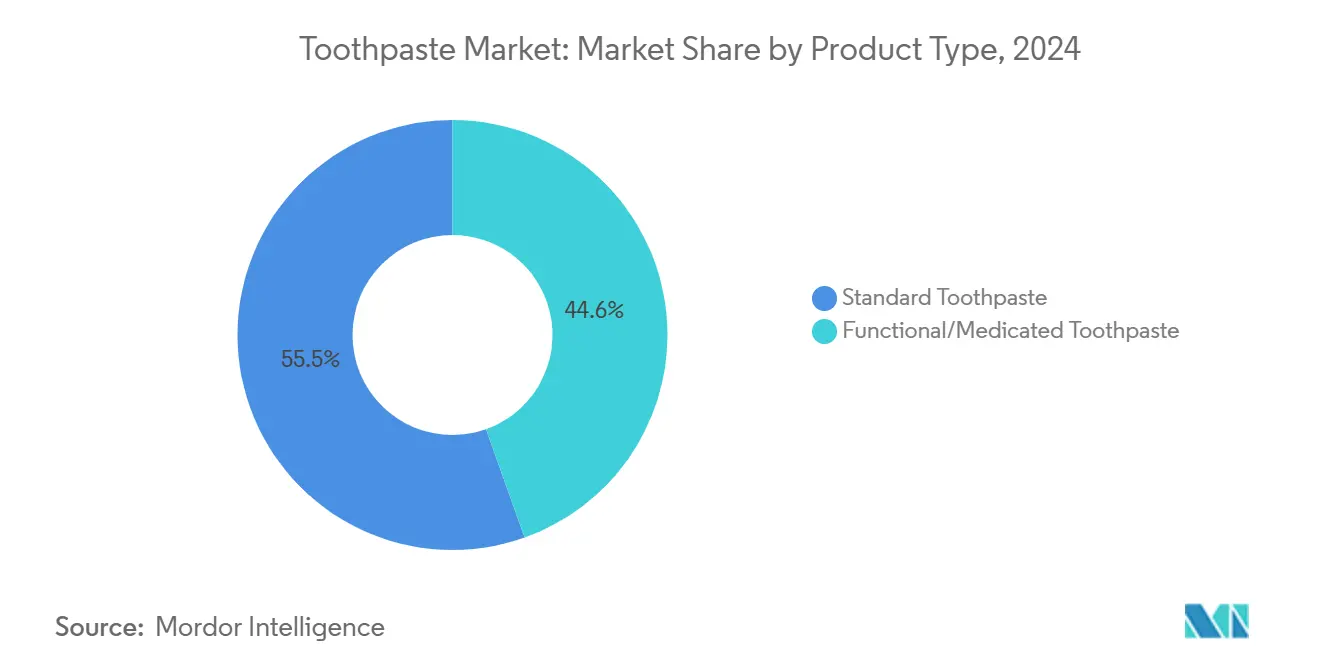
By Category: Natural Lines Reinforce Dual-Track Growth
Conventional formulas dominated with 74.35% share in 2024, yet natural and organic alternatives expanded 2.95% annually in the global toothpaste market. The natural toothpaste segment is experiencing accelerated growth in the Asia-Pacific region, driven by consumer trust in Ayurveda-based ingredients. Leading companies are incorporating neem, charcoal, and coconut derivatives with low-dose fluoride to deliver a balance of performance and safety. Differentiation in the competitive landscape is achieved through ingredient-origin narratives, recyclable packaging, and cruelty-free certifications.
Although the natural toothpaste market remains relatively small in absolute revenue terms, its high gross margins and strong brand-community engagement enhance profitability. However, regulatory harmonization remains a challenge, as inconsistent definitions of 'natural' require multinational companies to manage region-specific compliance, increasing operational complexity. Over the forecast period, hybrid toothpaste formulations combining botanical actives with clinically validated synthetic ingredients are expected to attract crossover consumers, mitigating the risk of cannibalization across product tiers.
By Distribution Channel: Digital Commerce Reconfigures Reach
Supermarkets and hypermarkets still drive 31.43% of global value owing to consolidated weekly shopping trips and prominent off-shelf displays. Yet the 3.75% CAGR recorded by pure-play e-commerce signals structural channel migration. Subscription models supplying three-month kits are pushing reorder stickiness beyond bricks-and-mortar parity. Marketplaces also surface micro-brands employing data-driven segmentation to address vegan or whitening-focused micro-niches, arming them with granular merchandising dashboards previously unavailable. As reported by the US Census Bureau, supermarket and grocery store sales in the United States amounted to USD 854.89 billion in 2024, reflecting the sector's significant contribution to the retail landscape [3]Source: US Census Bureau, "Advance Monthly Sales for Retail and Food Services", www.census.gov.
For incumbent giants, omnichannel execution now entails harmonized pricing, click-and-collect alliances with grocers, and last-mile micro-fulfillment to uphold cold-chain integrity for probiotic pastes. Supply-chain digitization, including demand-sensing algorithms, is essential to prevent online stockouts that fall straight to challenger brands. In the medium term, the toothpaste market is likely to balance at a mixed model where online captures incremental trial and auto-delivery replenishment while physical stores retain experiential discovery and immediate-need purchases.
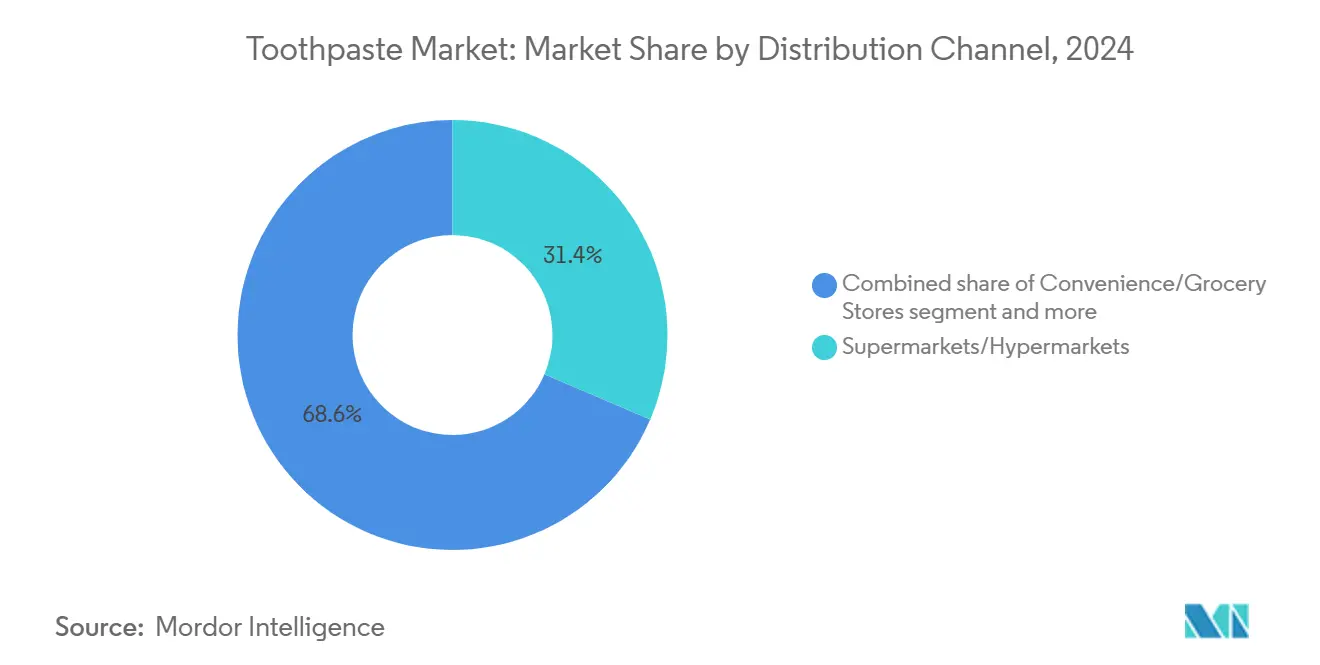
Note: Segment shares of all individual segments available upon report purchase
By End User: Adult Core Stable, Pediatric Upswing Builds
Adults commanded 84.35% consumption in 2024 in the toothpaste market, reflecting larger population cohorts and entrenched daily routines. In North America and Europe, replacement cycles have reached their peak. As a result, growth now focuses on value-added offerings, such as sensitivity relief and whitening, which support premium pricing strategies. While the adult segment benefits from strong brand loyalty and consistent usage patterns, it faces saturation in developed markets where per-capita consumption is nearing its limit. Premium adult formulations targeting specific needs, including sensitivity, whitening, and gum health, deliver higher profit margins and drive value growth despite stagnant volume growth.
Meanwhile, the children's segment is projected to grow at a CAGR of 3.27%, driven by increased parental focus on early cavity prevention and innovative flavors that encourage brushing compliance. Products like fruity gels and mild-foam formulas, designed to reduce gag reflexes, have improved adherence rates, as reported by pediatric dentists. With rising child populations in markets like India and Indonesia, this segment has the potential to capture a larger share of the toothpaste market, provided manufacturers comply with permissible sweetener limits and introduce child-safe caps that align with stricter safety regulations.
Geography Analysis
In 2024, the Asia-Pacific region contributed 34.57% of global revenues for the toothpaste market and is projected to achieve a 4.25% CAGR, outperforming all other regions. Key growth drivers include high population density, an expanding middle class, and government-supported oral health initiatives. Rural households are increasingly shifting from traditional neem twigs to modern packaged toothpaste, driven by messaging that highlights hygienic convenience. Local players such as Patanjali and Lion are intensifying competition with culturally relevant herbal products, prompting multinational companies to adapt by localizing flavors with ingredients like miswak and matcha.
North America, a mature yet high-value market, is experiencing stable volumes alongside a noticeable premiumization trend. Consumer preferences for sustainability and ingredient transparency are shaping purchasing decisions, leading to the early adoption of recyclable HDPE tubes and fluoride-xylitol hybrid toothpaste. Additionally, regulatory guidance from the FDA on maximum fluoride ppm has strengthened consumer trust, enabling mid-single-digit value growth despite stagnant volumes.
Europe, similar to North America in market maturity, places a stronger emphasis on sustainability, driving rapid adoption of mono-material barrier tubes certified for curbside recycling. However, rising price pressures are mitigated by the growing presence of discount retailers in Southern and Eastern Europe, necessitating cost optimization even for eco-friendly product lines. While Western Europe’s toothpaste market remains significant, price-sensitive consumers are increasingly opting for store brands. To counter this shift, leading brands are employing digital coupons and loyalty app strategies to secure shelf space.
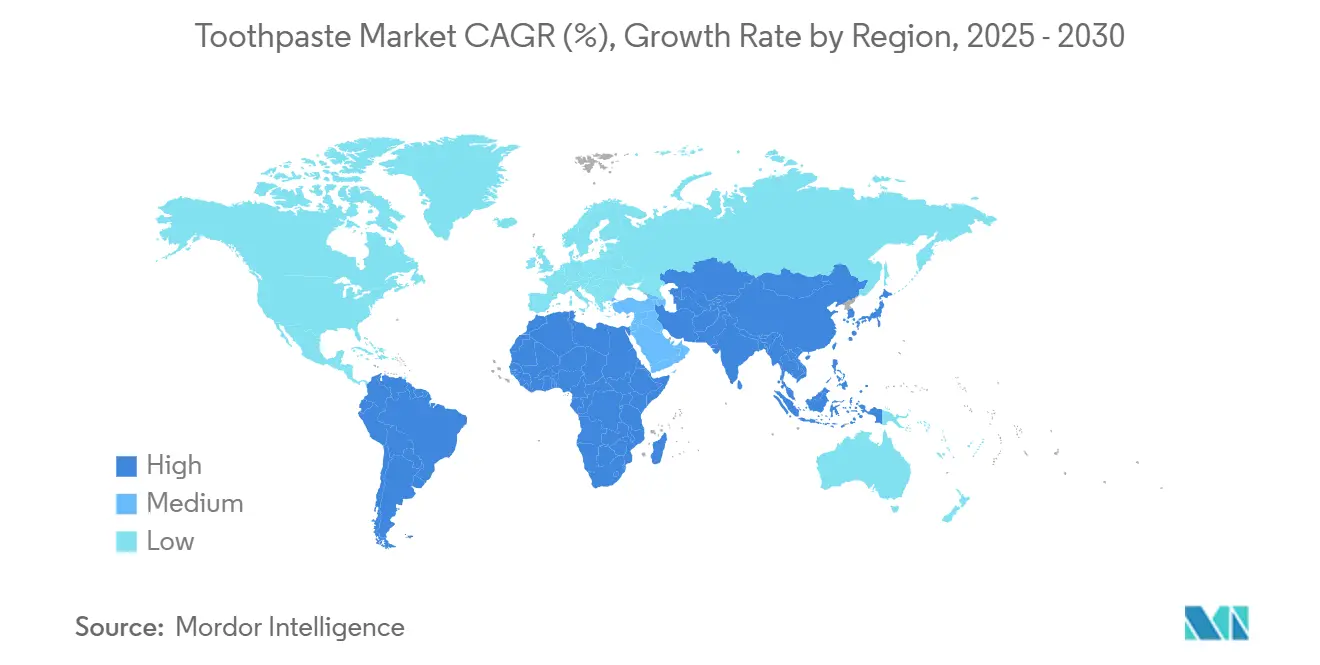
Competitive Landscape
The toothpaste market hosts a moderately consolidated structure, with major players Colgate-Palmolive Company, The Procter and Gamble Company, Unilever Plc, Lion Corporation, and Haleon PLC. The market includes numerous regional players, but global leaders maintain a dominant position in the toothpaste industry. These key players are capitalizing on growth opportunities in emerging markets to diversify their product portfolios and meet varying consumer demands, particularly for sensitivity and pain relief solutions. However, advanced distribution networks and manufacturing capabilities provide manufacturers with a competitive advantage to expand their global product offerings.
Sustainability has become a core focus of strategic initiatives. Haleon is integrating oral-health literacy campaigns with QR-linked educational content, enhancing expert credibility while collecting first-party data. Similarly, Unilever's planned divestment of its Ice Cream division reflects a strategic shift toward prioritizing core personal-care categories, reallocating resources to oral-care research and development, and media investments in emerging markets.
Digital commerce is driving disruption, with agile entrants targeting environmentally conscious consumers through chewable tablets and powder refills packaged in compostable materials. Although their scale remains limited, their socially-driven narratives appeal to affluent early adopters, compelling established players to accelerate their direct-to-consumer strategies. Between 2025 and 2030, competitive differentiation will depend on balanced portfolios that combine high-margin therapeutic products with mass-market offerings, while delivering measurable environmental benefits and robust digital customer experiences.
Toothpaste Industry Leaders
-
Lion Corporation
-
Unilever PLC
-
Colgate-Palmolive Company
-
The Procter and Gamble Company
-
Haleon PLC
- *Disclaimer: Major Players sorted in no particular order
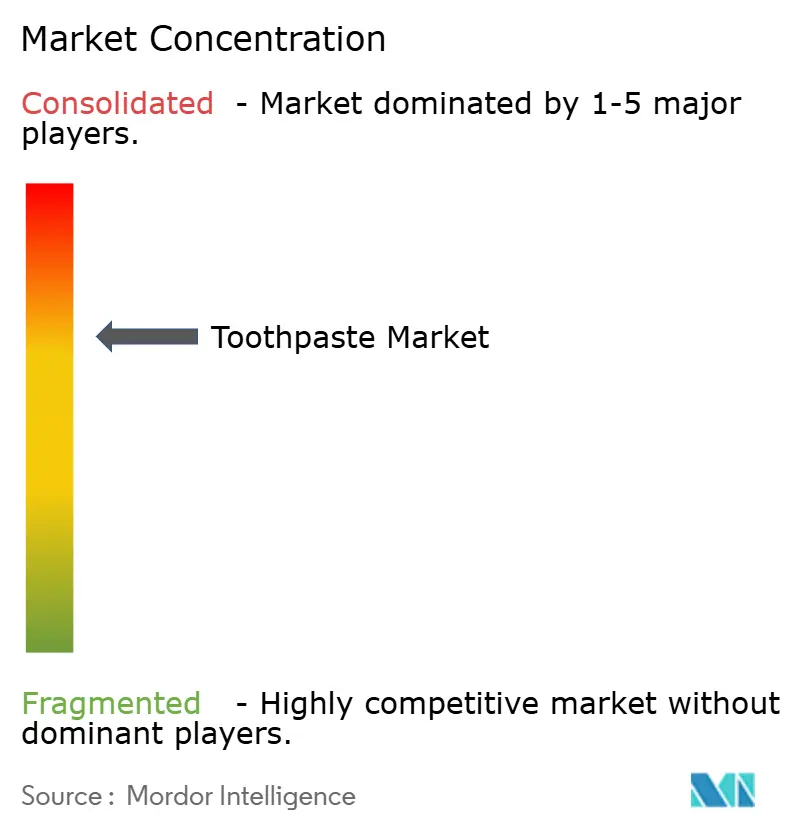
Recent Industry Developments
- April 2025: Unilever has introduced Closeup's White Now toothpaste, a premium product line developed in collaboration with beauty-focused Gen Z consumers. This range leverages advanced whitening technology to enhance the positioning of oral care products within the beauty-oriented market segment.
- March 2025: Lion Corporation has launched nationwide sales of CLINICA PRO plus Periodontal Barrier Toothpaste under its CLINICA PRO line of medicated toothpastes, distinguishing it as the only enzyme-formulated toothpaste available in Japan.
- February 2025: Colgate-Palmolive launched its comprehensive Colgate Total Active Prevention oral health system in Latin America, featuring advanced stannous fluoride stabilization technology.
- November 2024: The Procter and Gamble launched Crest 3DWhite Deep Stain Remover, expanding its whitening portfolio with advanced stain removal technology targeting deep discoloration issues
Research Methodology Framework and Report Scope
Market Definitions and Key Coverage
According to Mordor Intelligence, the toothpaste market embraces every factory-filled formulation, paste, gel, or powder sold for daily mechanical cleaning of human teeth; whitening, sensitivity relief, herbal, and medicated variants all fall within scope. Unit packs sold loose, boxed, or bundled through offline and online retail, dental clinics, and direct-to-consumer channels are counted at manufacturer selling price.
Scope exclusion: Professional in-office prophylaxis pastes and mouth-wash products are deliberately left outside the frame.
Segmentation Overview
- By Product Type
- Standard Toothpaste
- Functional/Medicated Toothpaste
- By Category
- Conventional
- Natural/Organic
- By End User
- Adult
- Kids
- By Distribution Channel
- Supermarkets/Hypermarkets
- Convenience/Grocery Stores
- Pharmacies/Drug Stores
- Online Retail Stores
- Other Distribution Channels
- By Geography
- North America
- United States
- Canada
- Mexico
- Rest of North America
- Europe
- Germany
- United Kingdom
- Italy
- France
- Spain
- Netherlands
- Poland
- Belgium
- Sweden
- Rest of Europe
- Asia-Pacific
- China
- India
- Japan
- Australia
- Indonesia
- South Korea
- Thailand
- Singapore
- Rest of Asia-Pacific
- South America
- Brazil
- Argentina
- Colombia
- Chile
- Peru
- Rest of South America
- Middle East and Africa
- South Africa
- Saudi Arabia
- United Arab Emirates
- Nigeria
- Egypt
- Morocco
- Turkey
- Rest of Middle East and Africa
- North America
Detailed Research Methodology and Data Validation
Primary Research
Mordor's team interviewed senior buyers at supermarket chains, practicing dentists across five regions, and R&D leads at private-label fillers; their insights refined channel mix splits, seasonality patterns, and average grams per brush assumptions that raw desk data could not fully expose.
Desk Research
Our analysts began with publicly available pillars such as UN Comtrade shipment codes for dentifrices, WHO oral disease prevalence bulletins, Euromonitor retail scanner extracts, and industry association dashboards from the American Dental Association and Japan Oral Care Association. Annual reports and 10-Ks of leading brand owners supplied ASP trends, while customs filings clarified cross-border flows into high-growth Asia. Subscription resources, D&B Hoovers for company financials and Dow Jones Factiva for deal news, helped stitch competitive moves to volume swings.
Country census updates, household expenditure surveys, and patent filings (via Questel) further grounded per capita usage curves and innovation pacing. The sources listed here illustrate, not exhaust, the broader document set our desk review covered.
Market-Sizing & Forecasting
A top-down demand pool, reconstructed from population x average brushing frequency x grams per brush x retail purchase share, set the 2025 baseline. Results were cross-checked through selective bottom-up supplier roll-ups and e-commerce channel checks, then adjusted where variance exceeded 5 percent. Key model fingerprints include adult to child population ratio shifts, emerging market GDP per capita, fluoride-free share progression, retail e-commerce penetration, and average selling price inflation. Five-year forecasts deploy multivariate regression on these variables, supplemented by scenario tests for raw material cost spikes. Gaps in bottom-up inputs, for instance unreported private labels, were bridged with proxy ratios taken from analogous markets after expert validation.
Data Validation & Update Cycle
Outputs pass a tiered review: automated anomaly flags, peer analyst audit, and senior lead sign-off. Models refresh each year, with rapid revisions when material events, regulatory bans, significant M&A, disturb underlying drivers, ensuring buyers always receive the latest vetted view.
Why Mordor's Toothpaste Baseline Is Trusted by Decision-Makers
Published values seldom align because firms choose differing product baskets, price bases, and refresh cadences.
By anchoring on full-category dentifrice volumes and validating both top-down demand math and bottom-up supply cues, Mordor delivers a balanced figure clients can trace to clear levers.
Benchmark comparison
| Market Size | Anonymized source | Primary gap driver |
|---|---|---|
| USD 29.32 B | Mordor Intelligence | - |
| USD 24.40 B | Global Consultancy A | excludes natural/organic lines; uses retail point of sale margins |
| USD 22.87 B | Industry Tracker B | relies on sample country roll-outs, limited ASP normalization |
| USD 20.14 B | Trade Journal C | omits online DTC sales and treats children's SKUs as niche add-ons |
The comparison shows that variance stems mainly from scope truncation and price stack choices; by covering every formulation, channel, and geography, Mordor provides the most dependable, repeatable baseline for strategic planning.
Key Questions Answered in the Report
What is the current value of the toothpaste market?
The toothpaste market reached USD 29.32 billion in 2025 and is on track to touch USD 32.45 billion by 2030, growing at a 2.05% CAGR.
Which region contributes the most to global revenues?
Asia-Pacific leads with 34.57% share and also delivers the fastest 4.25% CAGR, reflecting rising middle-class spending and increased oral-health awareness.
What segments are expanding quicker than the overall market?
Functional/medicated pastes, natural/organic variants, kids formulations and online retail channels all post higher CAGRs than the headline 2.05% rate.
Are recyclable toothpaste tubes becoming mainstream?
Yes. By early 2025, 90% of toothpaste tubes sold in the United States were compatible with HDPE recycling streams, and similar transitions are underway worldwide.
Page last updated on:
